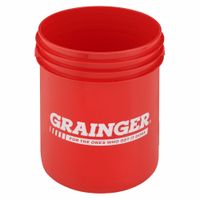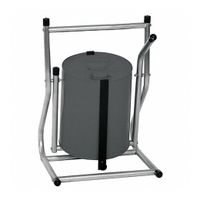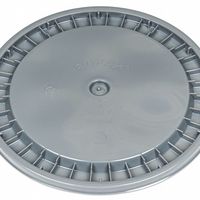Call +(254) 703 030 000 / 751 483 999 / 721 704 777
- Home
- Material Handling
- Storage Workspace
- Drums Pails Ibc Totes Tanks
- Storage Pails Pail Handling Equipment
.....Read More
Frequently Asked Questions
What are the different types of storage pails and their uses?
Storage pails come in various types, each designed for specific uses:
1. **Plastic Pails**: Made from high-density polyethylene (HDPE), these are lightweight, durable, and resistant to chemicals. They are commonly used for storing food, chemicals, and paints. Their airtight lids make them ideal for preserving freshness and preventing contamination.
2. **Metal Pails**: Typically made from steel or tin, these pails are robust and can withstand high temperatures. They are often used for storing flammable or hazardous materials, as well as for industrial applications. Metal pails are also used in construction for carrying heavy materials.
3. **Food-Grade Pails**: These are specifically designed to meet food safety standards. Made from food-safe plastic, they are used for storing bulk food items like grains, flour, and liquids. They often come with airtight lids to maintain freshness.
4. **Utility Pails**: These versatile pails are used for general purposes such as cleaning, gardening, and household storage. They are usually made from plastic and come in various sizes.
5. **Collapsible Pails**: Made from flexible materials like silicone, these pails can be folded flat for easy storage. They are ideal for camping, fishing, and other outdoor activities where space is limited.
6. **Decorative Pails**: Often made from metal or plastic, these pails are used for aesthetic purposes, such as gift packaging or home decor. They come in various colors and designs.
7. **Insulated Pails**: Designed to maintain temperature, these pails are used for transporting temperature-sensitive items like ice cream or pharmaceuticals. They are often used in catering and medical industries.
Each type of pail is designed to meet specific needs, ensuring safe and efficient storage and transport of various materials.
How do you choose the right pail handling equipment?
1. **Assess Needs**: Determine the type, size, and weight of pails you handle. Consider the frequency and volume of handling required.
2. **Environment**: Evaluate the workspace layout, including aisle width, ceiling height, and floor conditions. Consider any environmental factors like temperature or humidity that might affect equipment performance.
3. **Safety**: Prioritize equipment that enhances safety, reducing the risk of spills, injuries, or product damage. Look for features like ergonomic designs and secure grips.
4. **Efficiency**: Choose equipment that improves workflow efficiency. Consider the speed of operation and ease of use to minimize downtime and labor costs.
5. **Versatility**: Opt for equipment that can handle various pail sizes and types if your operations require flexibility.
6. **Durability**: Select equipment made from robust materials that can withstand regular use and harsh conditions, ensuring longevity and reliability.
7. **Budget**: Balance cost with quality. Consider initial investment, maintenance, and potential savings from increased efficiency and reduced labor costs.
8. **Compliance**: Ensure the equipment meets industry standards and regulations for safety and performance.
9. **Supplier Reputation**: Choose reputable suppliers with good customer support and service options.
10. **Trial and Feedback**: If possible, test the equipment in your environment and gather feedback from operators to ensure it meets your needs effectively.
What materials are storage pails made from?
Storage pails are commonly made from the following materials:
1. **Plastic**:
- **High-Density Polyethylene (HDPE)**: Known for its strength and durability, HDPE is resistant to impact, chemicals, and moisture, making it ideal for storing a variety of substances.
- **Polypropylene (PP)**: Offers good chemical resistance and is often used for pails that require a higher temperature tolerance.
- **Polyethylene Terephthalate (PET)**: Used for its clarity and strength, often in applications where visibility of the contents is important.
2. **Metal**:
- **Steel**: Provides excellent strength and is often used for industrial applications. Steel pails can be coated or lined to prevent rust and corrosion.
- **Tinplate**: A type of steel coated with tin, offering corrosion resistance and often used for food storage or paint.
3. **Stainless Steel**: Offers superior corrosion resistance and is used in environments where hygiene is critical, such as in food processing or pharmaceuticals.
4. **Aluminum**: Lightweight and resistant to corrosion, aluminum pails are used for both industrial and consumer applications.
5. **Fiber**: Made from compressed paper or cardboard, fiber pails are often used for dry goods and are typically lined with a plastic or foil layer to provide moisture resistance.
6. **Composite Materials**: These pails combine different materials, such as plastic and metal, to enhance specific properties like strength, durability, or chemical resistance.
Each material offers distinct advantages depending on the intended use, such as chemical compatibility, durability, cost, and regulatory compliance.
How do you properly clean and maintain storage pails?
1. **Empty the Pail**: Remove any contents and dispose of them properly.
2. **Rinse with Water**: Use warm water to rinse out any residue or debris.
3. **Apply Cleaning Solution**: Use a mild detergent or a mixture of water and vinegar. For tougher stains, a baking soda paste can be effective.
4. **Scrub Thoroughly**: Use a non-abrasive scrub brush or sponge to clean the interior and exterior surfaces. Pay attention to corners and seams.
5. **Rinse Again**: Thoroughly rinse the pail with clean water to remove any soap or cleaning solution.
6. **Sanitize**: If the pail is used for food storage, sanitize it with a solution of 1 tablespoon of bleach per gallon of water. Let it sit for a few minutes.
7. **Final Rinse**: Rinse thoroughly with clean water to remove any bleach residue.
8. **Dry Completely**: Allow the pail to air dry completely, preferably in a well-ventilated area or under direct sunlight to prevent mold and mildew.
9. **Inspect for Damage**: Check for cracks, warping, or any signs of wear that could compromise the pail's integrity.
10. **Store Properly**: Store the pail in a clean, dry place. Keep the lid off or slightly ajar to prevent odors and moisture buildup.
11. **Regular Maintenance**: Clean the pail regularly, especially if used for perishable items, to maintain hygiene and extend its lifespan.
What are the benefits of using open-head vs. closed-head storage pails?
Open-head storage pails offer easy access, making them ideal for materials that need frequent use or inspection. They are suitable for storing solids, semi-solids, or thick liquids, as the wide opening allows for easy scooping or pouring. Open-head pails are often used in industries like food service, construction, and manufacturing, where quick access to contents is essential. They also facilitate easy cleaning and refilling, which is beneficial for reusable applications.
Closed-head storage pails, on the other hand, provide a more secure and tamper-evident seal, making them ideal for storing liquids or hazardous materials that require protection from contamination or spillage. The sealed design minimizes the risk of leaks and evaporation, preserving the integrity of the contents. Closed-head pails are often used in chemical, pharmaceutical, and oil industries, where maintaining the purity and safety of the contents is crucial. They are also more suitable for long-term storage and transportation, as they offer better protection against environmental factors.
In summary, open-head pails are advantageous for ease of access and handling, while closed-head pails offer superior security and protection for sensitive or hazardous materials. The choice between the two depends on the specific needs of the application, including the type of material being stored, frequency of access, and required level of security.
How do you ensure the safe transport of storage pails?
To ensure the safe transport of storage pails, follow these steps:
1. **Material Selection**: Use durable, high-quality materials for pails to withstand handling and environmental conditions.
2. **Proper Sealing**: Ensure lids are tightly sealed to prevent leaks. Use tamper-evident seals for added security.
3. **Labeling**: Clearly label pails with contents, handling instructions, and hazard warnings if applicable.
4. **Stacking**: Stack pails properly to prevent tipping. Use interlocking designs or secure with straps.
5. **Palletization**: Place pails on pallets for stability. Use shrink wrap or straps to secure them to the pallet.
6. **Weight Distribution**: Distribute weight evenly on pallets to prevent shifting during transport.
7. **Handling Equipment**: Use appropriate equipment like forklifts or pallet jacks to move pails, reducing manual handling risks.
8. **Transport Conditions**: Maintain appropriate temperature and humidity levels during transport to prevent damage.
9. **Vehicle Safety**: Ensure transport vehicles are in good condition and equipped with necessary safety features.
10. **Driver Training**: Train drivers on safe handling and emergency procedures for transporting pails.
11. **Regulatory Compliance**: Adhere to local and international regulations regarding the transport of specific materials.
12. **Inspection**: Regularly inspect pails and packaging for damage before and after transport.
13. **Emergency Preparedness**: Have a plan in place for spills or accidents, including spill kits and emergency contact numbers.
14. **Documentation**: Keep accurate records of contents, transport conditions, and handling instructions.
15. **Insurance**: Obtain appropriate insurance coverage for the goods being transported.
By following these guidelines, you can minimize risks and ensure the safe transport of storage pails.
What accessories are available for storage pails to enhance their functionality?
1. **Lids**: Snap-on or screw-on lids provide secure sealing to prevent spills and contamination. Some lids come with spouts for easy pouring.
2. **Handles**: Ergonomic handles or grip attachments make carrying heavy pails more comfortable and reduce strain.
3. **Spouts and Pouring Attachments**: These allow for controlled dispensing of liquids, reducing waste and mess.
4. **Liners**: Disposable or reusable liners protect the pail's interior, making cleaning easier and extending the pail's lifespan.
5. **Dolly or Caster Wheels**: Attachments that allow pails to be easily moved, especially useful for heavy loads.
6. **Pail Openers**: Tools designed to easily open sealed lids without damaging the pail or lid.
7. **Funnels**: Attachments that facilitate the transfer of liquids or granular materials into the pail without spillage.
8. **Spigots**: Installed at the bottom of the pail for easy dispensing of liquids without lifting the pail.
9. **Stacking Rims**: Allow pails to be securely stacked on top of each other, saving space.
10. **Labels and Markers**: Waterproof labels or marker attachments for easy identification of contents.
11. **Mixing Attachments**: Devices that fit onto the pail for mixing contents without transferring to another container.
12. **Insulating Jackets**: Wraps that maintain the temperature of the pail's contents, useful for temperature-sensitive materials.
13. **Security Seals**: Tamper-evident seals to ensure the contents have not been accessed or altered.
14. **Pail Pumps**: Manual or electric pumps for dispensing liquids directly from the pail.
15. **Hanging Brackets**: Allow pails to be hung on walls or racks, saving floor space.
16. **Drum Wrenches**: Tools for tightening or loosening lids and spouts securely.



